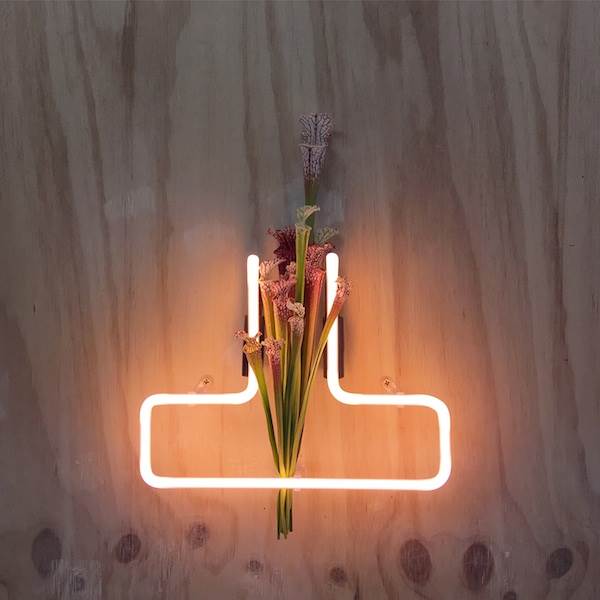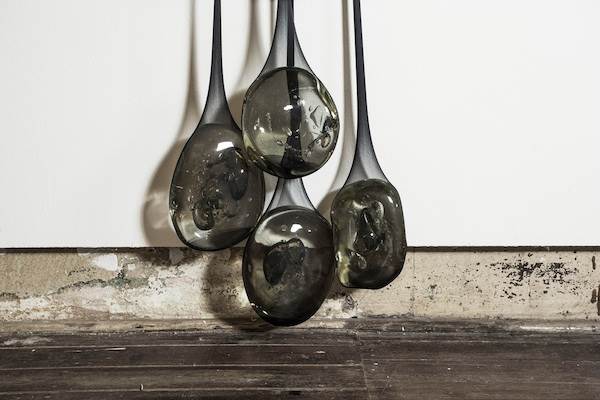‘Intrinsic Properties / Inherent Vice’ and ‘Ontogenesis’ are two concurrent glass exhibitions curated by Holly Williams for the Belconnen Arts Centre poised to coincide with Canberra’s Ausglass Conference. The art works on view in the main gallery were chosen as they sit outside of the specific ‘studio glass’ realm, drawn from the practices of Stevie Fieldsend, Yhonnie Scarce, Anna McMahon, Kenzee Patterson, Michaela Gleave, Patrick Pound and Sandra Selig. “Few materials are as compelling, duplicitous or as difficult to work with. Nevertheless, glass, in all its forms, makes our lives more livable,” explained Williams who specialises in interdisciplinary practices and is a co-founder of independent initiative The Curators Department.
In the foyer ‘Ontogenesis’ will stage pieces by recent Australian National University graduates Ngaio Fitzpatrick, Madisyn Zabel and John White who Williams perceives display an innovative approach to their medium by incorporating new materials and processes. She added, “As emerging professionals, they represent a growing wave of artists who are promoting the extension of craft-based skills within a broader context.” Cast sections of glass with projected geometric forms in wire and string mark Zabel’s compositions. Nixon’s glass urns incorporate nostalgic and kitsch ornaments, while Williams describes White’s practice as mixed-media sculpture. Fitzpatrick creates video-based work exploring entropy, decay and the environment.

You’re known for working closely with artists, what came first here the group or a keen interest in glass?
My first experiences at art school were in the glass studio – I originally wanted to be a glass blower so my interest in the medium is longstanding, particularly its use as a conceptual material, rather than the ‘studio glass’ movement. This exhibition brings together existing work, with the exception of the new collection created by Patrick Pound who is an artist that I worked with for the ‘Living in the Ruins of the Twentieth Century’ exhibition in 2013. So there hasn’t been the opportunity to work as closely with the participating artists as I might like. It’s been an interesting process engaging artists with a show that is based on a material premise; the show attempts to bring together works that explore the range of counterpoints and contradictions of the material.

Perhaps we can divide the artists into two camps of emotional (Patrick Pound, Yhonnie Scarce, Stevie Fieldsend) and empirical (Anna McMahon, Kenzee Patterson, Michaela Gleave, Sandra Selig) investigation. Can you speak about a few of the individual works they will present?
Stevie and Yhonnie both come from working closely with glass, in direct and personal ways. In some ways Patrick’s work straddles both camps – his collection of glass-related objects unpacks some of the emotional geography that glass claims in recent material history. Kenzee’s work The bare wall, the blank page, the empty screen (2014) of meticulously painted ‘glass eyes’ featuring his own irises question both portraiture, agency and perception. The fact that they are actually fabricated from acrylic, in the context of this exhibition is also really interesting to me – further upending hard and fast rules that surround material definitions. Anna McMahon includes both sheet glass, broken fragments and neon across the range of her practice – her incorporation of flowers and other botanical specimens with these materials is also quite unexpected and effective, forming links with temporality and aesthetics through the combination of these elements.
Can a static skill or form be innovative? Must invention and borrowing be used to create something new?
I think the key thing here is that glass is so familiar to us as a material and it touches on so many aspects of our lives – from the banal and domestic to the technical and sublime. The artists in this exhibition turn their gaze and their inquisitiveness to something so ubiquitous that it allows for a new understanding in the viewers.

Do you think that ‘traditional’ mediums such as glass and ceramics are experiencing resurgence in popularity because there is so much to ‘mine’ from process?
There is great pleasure to be derived from the tactile process of creating ceramics and to some extent glass. I think the directness of working with these materials is very attractive to artists and the general public. In terms of process, many ways of working with glass, blowing and kiln casting for example, require a very intensive way of working and a big studio set up. Hopefully the surge in popularity and experimentation that ceramics is experiencing within contemporary art generally will be mirrored (pardon the pun) in the glass world. I think the exchange between disciplines has the potential to be very fruitful for artists and audiences alike.
‘Ontogenesis’ points to development from the earliest stage of something to its maturity – do the works in the foyer therefore represent an ‘end point’?
An end point, or possibly a leaping off point. There is evident maturity of skill that these artists are now utilising to push their ideas, and the perception of glass in the contemporary sphere, forward.
Belconnen Arts Centre
Until 5 March, 2017
Australian Capital Territory
Michaela Gleave, Eclipse Machine (Retrograde Motion), 2015, projection lamp, motors, optical glass, timber, stand, 90 x 90 x 140cm
Courtesy the artist and Anna Pappas Gallery, Melbourne
Anna McMahon, Untitled # 3, from the series ‘Soft outcomes’, 2016, neon, pitcher plants, 30 x 28cm
Photograph: Anna McMahon
Courtesy the artist
Stevie Fieldsend, Long Stretch, 2014, stocking, glass, soot, dimensions variable
Photograph: Jacquie Manning.
Courtesy the artist and Artereal Gallery, Sydney


